值班水手英语口语问答(1)
本文目录
Unit 1 Ship structure
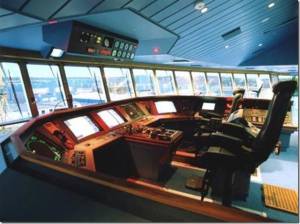
In general, a vessel is made up of two parts: the hull and the superstructure. The main body of a ship is the hull. The hull contains the engine room, cargo space and a number of tanks. At en fore end of the hull are the fore peak tanks and at the after peak tanks. They are used for fresh water and the water ballast. The space between the holds and the bottom of the hull contains double bottom tanks. These are used for ballast water and fuel. The deck extending from bow to stern is called main deck. The superstructure is above the main deck. It includes forecastle, bridge and poop. The forecastle is at the fore end. An ordinary cargo ship usually has five hold. They are numbered from forward to aft.
- How is a vessel made up of?
In general, a vessel is made up of two parts: the hull and the superstructure. - What is the main deck?
The deck extending from bow to stern is called main deck. - What are the fore peak tank used for?
They are used for fresh water and the water ballast. - What are the double bottom tanks used for?
They are used for ballast water and fuel. - What does the superstructure include?
It includes forecastle, bridge and poop. - How many holds does an ordinary ship have?
An ordinary cargo ship usually has five holds. - How are holds numbered?
They are numbered from forward to aft. - Where is the forecastle?
The forecastle is at the fore end.
Unit 2 Deck department
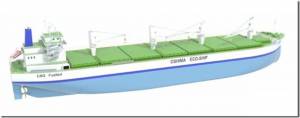
The deck department is made up of a number of officers and rating. The deck department is in charge of keeping watches. An officer is always on watch on the bridge. The chief officer is in charge of the deck department. The captain is an experienced navgator. He usually works out of the best course. He is in overall command of a ship. The deck department also includes a bosun, a carpenter and a number of ratings. These are made up of A.B. and O.S.. The bosun has a lot of knowledge and practical experience in seamanship. He is in charge of the sailor’s work. The carpenter is directly responsible to the chief officer. He sounds the tanks and bilges everyday. Cleaning, painting and repair work is done by ratings.
- How is deck department made up of?
The deck department is made up of a number of officers and ratings. - Who is in charge of deck department?
The chief officer is in charge of the deck department. - How are ratings made up of?
They are made up of A.B. and O.S.. - Where is an officer on watch?
An officer is always on watch on the bridge. - Who is in overall command of a ship?
The captain in overall command of a ship. - What is the main job for the carpenter?
He sounds the tanks and bilges everyday. - What is the buson’s responsibility?
The buson has a lot of knowledge and practical experience in seamanship. He is in charge of the sailor’s work. - Is cleaning and painting work done by officers?
No, cleaning and painting work should be done by sailors.
Unit 3 Wheel order

When a ship proceed at sea or into harbor, it should be steered carefully. The pilot, the captain or officer on watch gives the wheel order to the helmsman. All wheel orders given should be repeated by the helmsman. All orders should be held until countermanded. The helmsman should report immediately if the vessel does not answer the wheel. “Port five”means that ship is going to alter course. The ship can not alter course as quickly as order is given. “Midships” refer to rudder to be held in position fore and aft. “Port a bit sluggish” means that port rudder answer slow. The helmsman should never mistake the port helm for the starboard helm and vise versa. A little carelessness may cause great danger.
- Who usually gives the wheel orders to the helmsman?
The pilot, the captain or officer on watch gives the wheel order to the helmsman. - After you receive the wheel order, what will you do first?
At first, I should reply the order loudly and clearly. Then after I have confirm the helm answered correctllym, I should report the wheel order to the person who have given me the order. - If the ship does not answer the wheel, what will you do?
I must report it to the person who have given me the order as soon as posible. I should report immediately if the vessel does not answer the wheel. - What does “Midships” mean?
“Midships” refer to rudder to be held in position fore and aft. - What does “port a bit sluggish” mean?
“Port a bit sluggish” means that port rudder answer slow. - The helmsman should never mistake the port helm for the helm ________.
The helmsman should never mistake the port helm for the starboard helm and vise versa. - Can the ship alter course as quickly as order is given?
The ship can not alter course as quickly as order is given. - A little carelessness may cause ________.
A little carelessness may cause great danger.
Unit 4 Mooring line
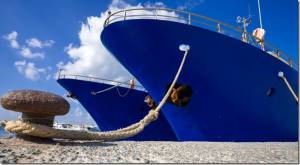
A ship is made fast to quayside by mooring lines. When a ship is getting alongside the wharf, 12 ropes will be usually used to moor the ship. The standard mooring lines are shown below. They consist of a headline. A breast line and a back spring forward, a stern line, a breast line and a back spring aft. The line leading forward to shore from the bow is called headline. The line leading at right angles to the center line from the forecastle to the shore is called the forward breast. The wire leading aft from the forecastle to the shore is called the forward spring. Any of these lines may be doubled. Each line has a large eye spliced in the end. The eye is placed over a bollard on the quayside. On shore, Lines may be heaved tight by a capstan or a windlass.
- By what is a vessel made fast to the quayside?
A ship is made fast to quayside by mooring lines. - A line leads forward from the bow to the shore. What is it called?
The line leading forward to shore from the bow is called headline. - How many ropes will be usually used to moor the ship?
When a ship is getting alongside the wharf, 12 ropes will be usually used to moor the ship. - Please list some of ship’s mooring lines.
They consist of a headline. A breast line and a back spring forward, a stern line, a breat line and a back spring aft. - What does the forward spring mean?
The wire leading aft from the forecastle to the shore is called the forward spring. - Where are lines made fast on shore?
On shore, lines are made fast on bollard. - Where are lines made fast on vessel?
On a vessel, lines are made fast on betts. - By what are lines heaved tight?
Lines may be heaved tight by a capstan or a windlass.
Unit 5 Gangway watch
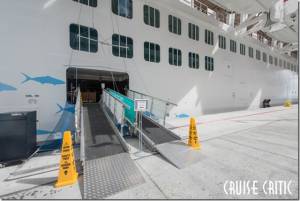
When a vessel is alongside the wharf, it’s necessary for the ship to keep a 24 hour gangway watch to guarantee the safety of the ship. Sailors are usually assigned to do the job. The main tasks for sailor on duty are, first of all, receiving the persons who come on board to do their business. The registry book should be filled in by the visitors. They should also take care of the gangway, the mooring line, anchors and son to ensure that they are in normal condition. When the tide is rising, the gangway should be lowered. If anything out of order is found, it should be reported to duty officer immediately. When the vessel has got alongside the wharf, a life buoy should be placed on the gangway.
- When a vessel is alongside the wharf, who are usually assigned to keep a gangway watch?
- Why is it necessary to keep a gangway watch when at wharf?
- What are the main tasks for sailor on duty first of all?
- Who should fill in the registry book?
- Can you list some dutys of the sailor on gangway watch?
- When the tide is rising, how do you adjust the gangway?
- If anything out of order happens, what should the duty sailor do?
- When the vessel has got alongside the wharf, what should be placed on the gangway?
Unit 6 Tools
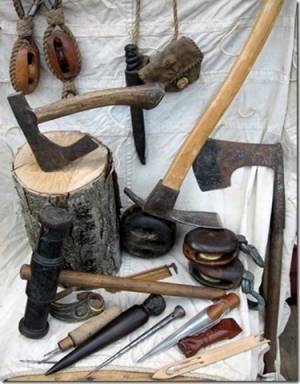
Sailor’s work consists of many kinds of work on deck. The daily cleaning and repairing, the derusting and painting, and the cargo lashing and unlashing are all done by sailors. To do these works, sailors need all kinds of tools. The bosun is in charge of the common tools, such as spanners, saws, axes, screwdrivers and so on. Chipping hammer is used for doing the derusting work. Claw hammer is used for pulling out the nails. Usually the chief officer is charge of the spares and stores of the deck department.
- Can you list some sailor’s work on deck?
- Where are the common tools usually stored?
- Who is in charge of the common tools?
- Are saws included in the common tools?
- Are derricks included in the common tools?
- When doing the derusting work, what tools is usually used?
- What is a claw hammer used for?
- Who is in Charge of spares and stores of the deck department?
Unit 7 Opening and closing hatches
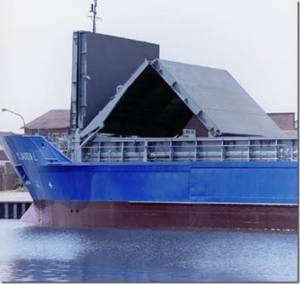
Before loading and discharging, the hatch covers will be opened. When the weather becomes bad or the loading and discharging is finished, the hatch covers will be closed. The work of opening and closing the hatch covers is usually done by the crew on board the ship. There are several types of hatch covers on board the ship. They are rolling types, side rolling type, folding type and so on. These hatch covers are usually driven by electric or hydraulic power. High speed operation and rough handling of covers are dangerous. During operation, the operators should keep themselves away from moving covers. Operate two or more hatch cover at same time is prohibited. The sailor should report it to the duty officer when the cover is deformed and damaged. After operation, the sailor should drop the control levers into stowing hole, and stop the electric motor.
- Who will usually do the work of opening and closing the hatch covers?
The work of opening and closing the hatch covers is usually done by the crew on board the ship. - What will you do when the weather becomes bad?
When the weather becomes bad I will close the hatch covers. - Can you name some different kinds of hatch cover?
There are several types of hatch covers on board the ship. They are rolling types, side rolling type, folding type and so on. - What are hatch covers usually driven by?
The hatch covers are usually driven by electric or hydraulic power. - Is it right to keep away from moving covers?
During operation, the operators should keep themselves away from moving covers. - Is it right operate two or more hatch cover at same time?
Operate two or more hatch cover at same time is prohibited. - What should you do if you found the cover is deformed and damaged?
I should report it to the duty officer when the cover is deformed and damaged. - What should you do after the operation?
After operation, I should drop the control levers into stowing hole, and stop the electric motor.
Unit 8 Cleaning and repairing work
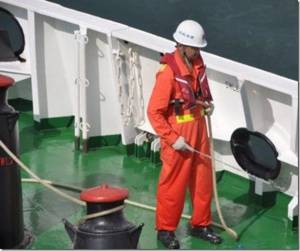
The maintenance work for sailors includes cleaning, repairing and painting work on board a ship. Cleaning is frequent job on board. The sailors often clean the ship with fresh water. Everything on board should be kept clean and tidy. The rubbish should be collected on the poop deck and disposed of 25 miles off the shore. Although a ship usually has her annual or voyage repair in a shipyard of dock, it is also necessary for her to carry out the general day-to-day repair on board. All the moving parts of the derricks need to be dismantled, inspected, cleaned and oiled. Wire rope should be greased every month or two and it should be kept on a reel when not in use. If the cargo wire has more than 10% broken wire, it should be renewed.
- What maintenance work should a duty sailor do?
The maintenance work for sailors includes cleaning, repairing and painting work on board a ship. But as a duty sailor, I will only be ordered by the duty officer on the bridge. - Do the sailor often clean the ship with sea water?
No. The sailors often clean the ship with fresh water. - Where should the rubbish be collected?
The rubbish should be collected on the poop deck. - How far should the disposed of off the shore?
The rubbish should be disposed of 25 miles off the shore. - Where does a ship usually has her annual or voyage repair?
A ship usually has her annual or voyage repair in a shipyard or deck. - Do all the moving parts of the derricks need to be dismantled?
Yes. All the moving parts of the derricks need to be dismantled, inspected, cleaned and oiled. - How often should the rope be greased?
Wire rope should be greased every month or two. - If the cargo wire has more than 10% broken wire, it should be renewed.
If the cargo wire has more than 10% broken wire, it should be renewed.
Unit 9 Emergency
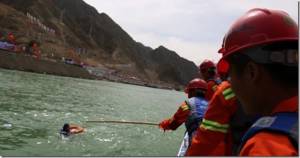
The muster list is posted in public places in defferent parts of the ship. After joining the ship, the crew members should familiarize themselves with their emergency duties and know what they should do during emergency. If there is a fire on board, they should inform the bridge and give the alarm at once. If man overboard, they should release a life buoy for him and help him on board. They should wear breathing apparatus before entering an enclosed space. They should also be clear about the meaning of the different alarm signals and the locations of their lifeboat station. The life boat is on the boat deck. On hearing the signal, the crew member should proceed immediately to carry out their assigned duty. For the duty assigned, one person may do more than one work and one work may be done by more the one person.
- Where is the muster list usually posted on board?
The muster list is posted in public places in different parts of the ship. - After joining the ship, what should the crew members familiarize?
After joining the ship, the crew members should familiarize themselves with their emergency duties and know what they should do during emergency. - If there is a fire on board, what should be done at once?
If there is a fire on board, they should inform the bridge and give the alarm at once. - If you find a man overboard, what will you do first?
If man overboard, I should release a life buoy for him and help him on board. - Before entering an enclosed space, what should you do?
I should wear breathing apparatus before entering an enclosed space. - Which deck is the life boat on?
The life boat is on the boat deck. - On hearing the signal, what should you do?
On hearing the signal, I should proceed immediately to carry out their assigned duty. - For the duty assingned, one person may do more than one work and one work may be done by more than one person.
Unit 10 Loading and discharging cargo
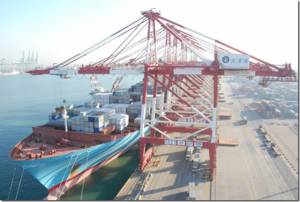
Different cargo needs different kinds of handling equipment to load or discharge. Liquid bulk cargo is loaded and discharged by pump. Dry bulk cargo is loaded automatically by bucket and conveyor or through large tubes. Some general cargo such as cotton, cement, rubber, steel, timber is handled by ship’s own derricks or shore cranes. During loading and discharging, there is a lot of work for duty sailor to do. He should to know the SWL of derricks on the ship and not allow the stevedores to over load the derricks and operate the winches roughly. They should operate the winch steadily. When the winch is in trouble, he must call the electrician to repair it. If there is anything unusual, the duty officer should be reported right away. Smoking on deck or stealing in hold is strictly prohibited. It is also duty sailor’s job to turn on or turn off the lights, hoist and lower the flag.
- By what equipment is the liquid cargo loaded and discharged?
Liquid bulk cargo is loaded and discharged by pump. - By what equipment is the general cargo loaded and discaharged?
Some general cargo such as cotton, cement, rubber, steel, timber is handled by ship’s own derricks or shore cranes. - Can you list some general cargo?
Such as cotton, cement,rubber, steel, timber are all general cargo. - If the cargo wire is going to break, what will you do?
If there is anything unusual, the duty officer should be reported right away. - Are the stevedores allowed to overload the derricks?
The stevedores to over load the derricks are not allowed. - How should the stevedores operate the winch?
They should operate the winch steadily. - The winch does not work, waht will be done then?
When the winch is in trouble, he must call the electrician to repair it. - Who will turn on or turn off the lights, hoist and lower the flag?
It is also duty sailor’s job to turn on or turn off the lights, hoist and lower the flag.
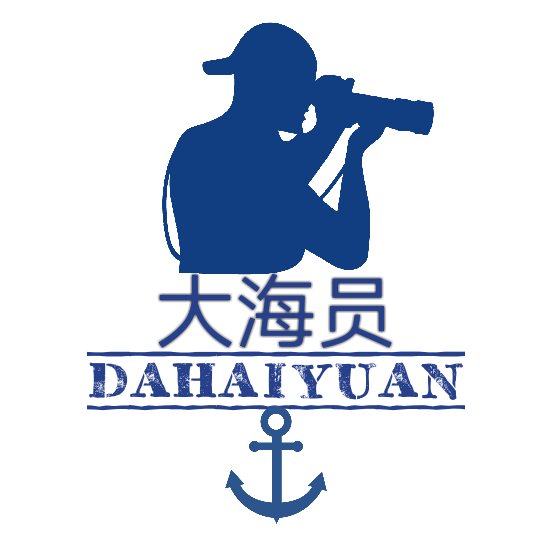


 有你的支持我会变得更好,微信扫一扫
有你的支持我会变得更好,微信扫一扫